10 Seriously Simple Ways to Grow Your Email List for Your WordPress Site
Building your email list is one of the most important steps in creating and successful and effective website. However, to be successful you need to understand the psychology behind it all...

If you’re serious about your website becoming successful, there’s one thing you really need to focus on. In fact, some people say it’s the ONLY thing your website should focus on.
Internet marketing legends such as Neil Patel and Jon Morrow design their own websites around this very important strategy:
Building an email list.
Why is it so important for you to build an email list?
- Because email allows you to develop a trusting relationship with your visitor,
- You have a chance to warm people up to your offer, and
- An article only has one chance to convert. With email you get a chance to convert with each email.
Now, starting this post talking about conversion is probably the wrong way to actually begin this article.
Why? Because before conversion comes trust.
Only after you’ve earned your users’ trust can you get them to take the action you want them to take, whether that’s trying and buying your product, engaging your services, paying for your course, or, heck, even visiting your brick and mortar shop.
Yes, the most effective way of building trust with your user is through email. This is why email list building is the single most important task you need to focus on when it comes to your WordPress website.
Why Is Email List Building So Effective?
Because it’s an email list to help you build a relationship with your users.
Without delving too deeply into this, there are several phases a user will go through before they start to trust you enough to engage with you and your website.
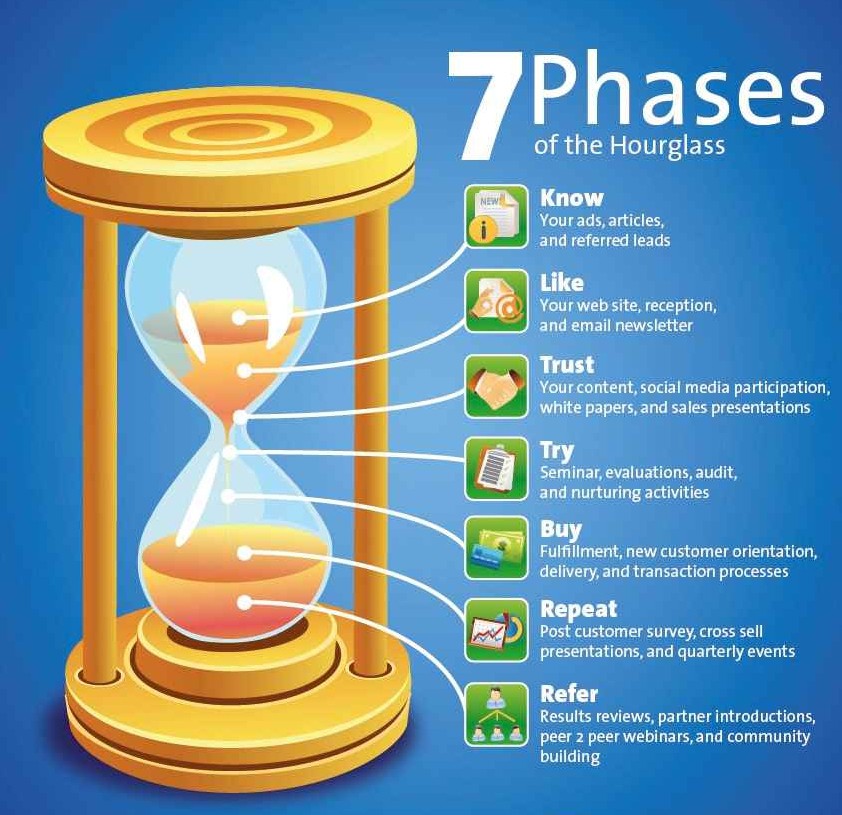
- Know – they become aware of your existence and/or presence
- Like – they are attracted by something you have to offer, whether that’s your content, your product, your services or anything else you have to offer them
- Trust – you earn their trust. Your users need to get to know you. You can do this by showing them that you are able to understand their situation/problem and can offer a solution for it
- Try – they test out your solution to their problem
- Buy – they are satisfied with your solution and are ready to give you their money
- Repeat – an existing customer is your easiest way to increase your sales. They already know you and trust you enough to buy, so they are your easiest sales target for repeat business
- Refer – they are so happy with your solution that they will actually be happy to speak about it with their peers
The first phase, getting to know you is outside the scope of this article. In the context of a website, this is about getting people to your website.
The second phase, Like, is what we will be discussing today; how your visitor can get to like you enough to give your their email address.
Once you have their email you can reach out to your users and nudge them towards the rest of the phases, from three to seven. Although I’d love to write about this, the subject is too deep and there are many articles out there that discuss these phases much better than I ever could.
Why Is Email List Building So Important?
People’s attention is limited. And scarce.
To make matters worse, everybody is clamouring for your attention. We are constantly assaulted by information and have almost become immune to it.
You usually only have a few seconds to REALLY capture somebody’s attention. If you’re not able to capture their attention in those initial few seconds, you’ve lost them (probably forever).
And, of course, the chances of you getting a second chance of meeting them again, virtually or otherwise, decrease significantly after that first encounter (with your content).
You need to maximize that “chance encounter” and convert that one-off user into a regular visitor who knows and trusts you. Besides adding traffic to your website, you could actually turn that chance encounter into a lead.
But how do you actually get that user to give you their email address if they don’t know you?
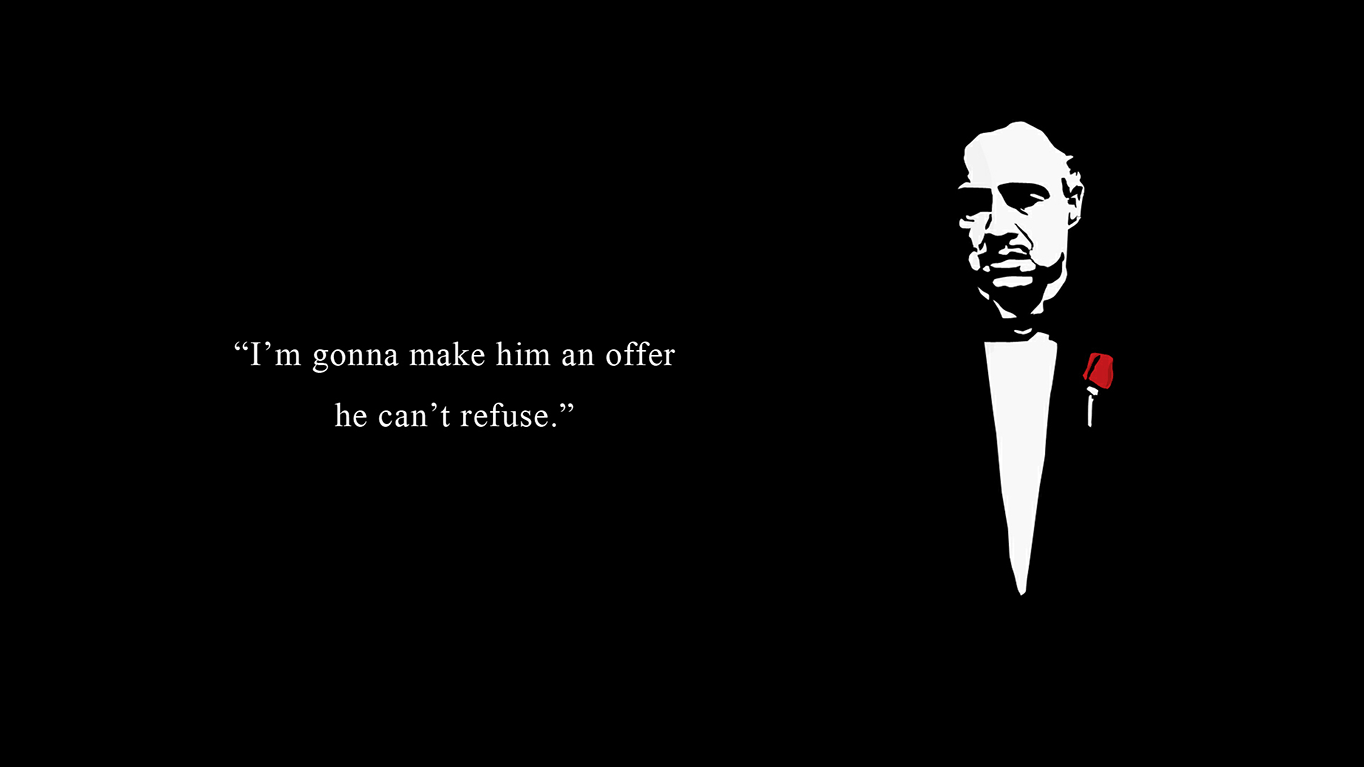
1. Focus on Your User’s Intent. Then Make Them an Offer They Can’t Refuse…
So we’ve been speaking about how capturing emails is important. How do we go about getting a user’s email address?
Let’s make one thing very clear: getting somebody’s email is very difficult.
In this day and age where unsolicited bulk email is prolific, people no longer regard email marketers as legitimate. In most user’s mind, any email that is sent with the intent of promoting or selling is SPAM.
We won’t go into the merits of that, but it’s the sort of environment you’ll be working in.
People simply don’t like being pitched to by sleazy sales people. Users know they have an agenda. And most people believe that any time they give an email address to a website they are opening their inbox to a deluge of “SPAM”.
Instead, you have to earn a user’s trust and make it clear that you will (mostly) not be selling to them.
How do you do this?
First of all, think about your user’s intent. Why have they visited your website?
Our assumption for every article we write is that the visitor has a problem they need a solution for.
Focus on that intent. Focus on that problem. And then give your visitors a solution.
Why should you make an offer they can’t refuse? Simply put, unless you have shown your users that your content is absolutely amazing, it’s hardly likely that they will “subscribe to your newsletter.”
On the other hand, if you make them an offer they cannot refuse, you are giving them value from the get go.
2. First Things First. Show Them Value through Your Content
A few paragraphs up, I mentioned like and trust.
To increase your chances of getting a user’s email address, you need to get them to like you and build up their levels of trust.
Building trust starts with writing excellent content.
Writing content so complete, so deep, so impressive and comprehensive around a specific topic, that your user will feel that they will be losing out if they walk away from it (and other content like it that you’ve created).
You need to convince users that sticking with you will bring them value.
That’s why I suggest writing in-depth content around a problem users are facing.
The article needs to say to the user, “look, I know what I’m talking about. You can trust me with helping you find a solution for the problem you are facing.”
3. Pique Their Interest. Give Them Additional Value (before Asking for an Email Address)
Once you’ve published some amazing content, your user is already pumped up. They are hyped and feel like your solution could be the one for them. They are ready to trust your next “phase” of the solution you are offering.
That’s when you make them an offer they can’t refuse.
The real difference between list-building that works and list building that doesn’t is this:
Give something. Don’t ask for anything.
Give something (of value to the user). Don’t (just) ask (for an email address).
Give them a valuable call-to-action, which includes handing over their email address to you.
Let’s discuss a few examples of how to give your users additional value.
The Free Download
The free download is a proven way of exchanging value for an email address. You provide the user with an offer they can’t refuse via a downloadable, which will clearly enhance their knowledge and/or build upon the article you have just written.
Example of free downloads include:
- Free ebook: This free eBook should compliment your article and offer new insights that you haven’t expanded on in the article. If we’re talking about email list building, you could offer an eBook, for example, about “10 email plugins to master communication with your subscribers.”
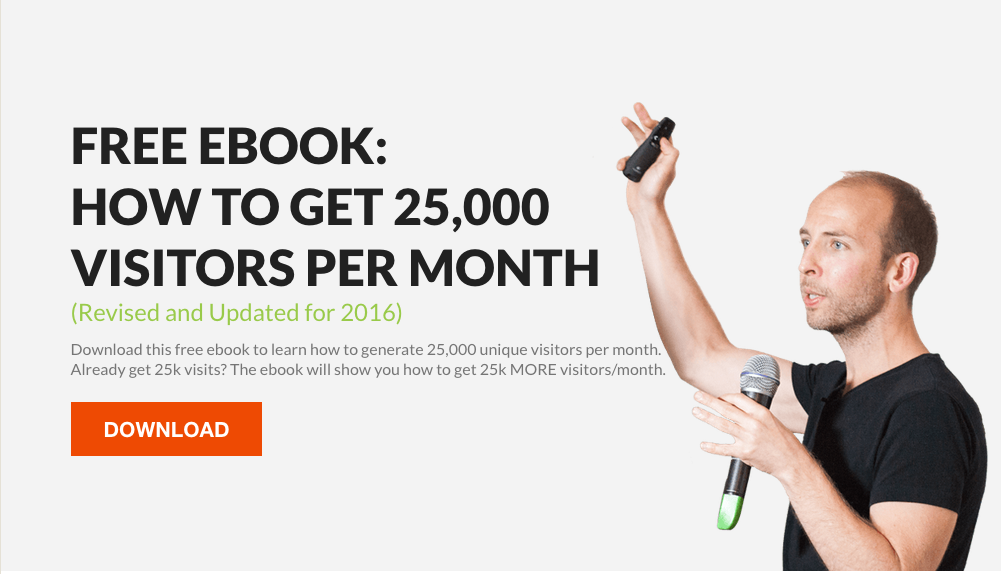
- Content-upgrade: This is very similar to the ebook, but rather than offering a different aspect, it’s actually a necessary extension to your current content. In essence, the most important part of the article would actually be provided when it’s unlocked through their email address.
- A downloadable checklist: Checklists are a fantastic way to divide a problem into a number of easier tasks. If you’ve written an article that includes a checklist, provide the checklist as a PDF download for printing or safe-keeping. The WordPress Security: The Ultimate 32-Step Checklist is a great example of creating a downloadable checklist.
- Help users with their processes: If you’ve been discussing ways and means of performing a process and can create a spreadsheet or document that is able to implement this process and saves the user from having to do it themselves, this could also be your free download.
- Help users with their research: If you’ve been researching a topic and have compiled a number of resources around this topic, save the user some time and offer these resources as a free download.
- Freebies: Designers and design agencies and digital content providers have a nice trick up their sleeve of offering a freebie against an email address. Web designers can get themes, PSDs, fonts, icons, plugins, photography, video, design kits, mockups. Music providers could give away albums, or previews. If you’re in the digital content business, you can easily find a great piece of content and offer it as a free download. This works for quite a few industries where digital downloads and freebies are popular.
The Free Email Course
Some problems require more than just one article to completely solve them. This is where an email course can create excellent value and build trust with your user.
Offer a “10 tips towards success” email course, which users can join.
The Exclusive Tips
When a user lands on your website after searching for specific content, you’ve no doubt already determined that they are typically looking to solve a specific problem. Obviously, that’s why they performed the search in the first place!
You can ride this wave of interest in your user by figuring out their user intent and then offering exclusive tips by email to help your user towards addressing their needs.
The Bribe
Some people are simply able to get away with asking for your email address and telling you they will send you unicorns and rainbows of great content. If you are in an influential position this is typically enough. People already trust you. Asking for the email address is just another way of giving them more valuable content.
4. Diversify Your Offer – One Size Does Not Fit All
OK, so you want to make your users an offer they can’t refuse.
This is all well and good, but what if the content of your content is pretty diverse?
Rather than having a single, one-size-fits-all offer, you’ll need to make several strong offers, each of which is customized to the specific content your user is visiting.
Now, this might seem like an impossible task if you have lots of content, though it is sufficient to simply change the wording around your call to action rather than the content itself.
At CollectiveRay, we have more than seven different campaigns, all making different offers depending on the content the user has landed on:

Good Examples, Bad Examples Of “The Offer They Can’t Refuse”
In theory, the offer they can’t refuse is great. But in practice, finding the right “offer” is tricky business.
Let’s review a few good examples, and then a few which, I believe, are not so great.
The Content Upgrade
This is an offer about more exclusive tips in a post about content upgrades. As you can see, it’s an offer you can’t refuse because if you’re on the specific topic. It would be great to finish off the read with three more exclusive tips.
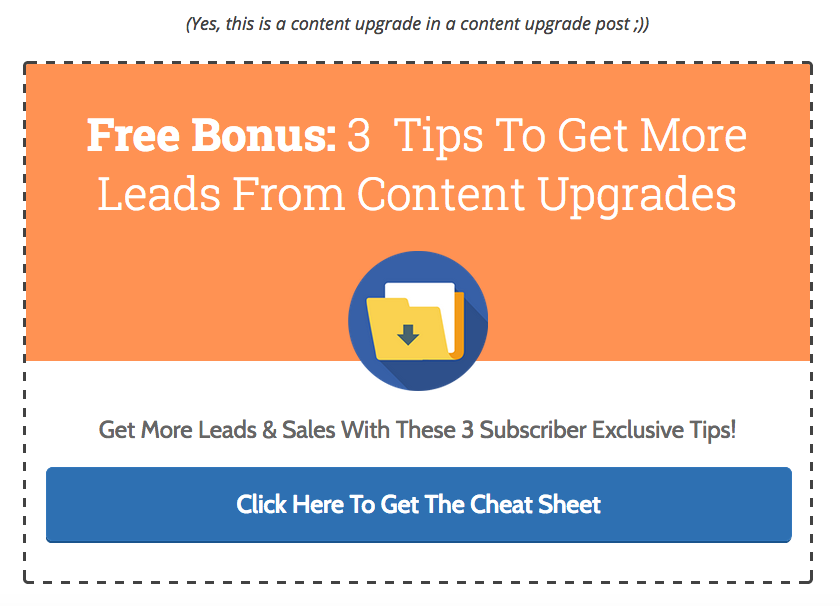
The After Content Opt-In
Jonathan Fields creates an excellent and fun opt-in “bribe” without a bribe. It’s fun, it’s creative, it attracts attention. It ticks all the right boxes.
There’s another fun email opt-in pop-up too, so visit the site and see whether you encounter it.

The Exit-Intent Popup
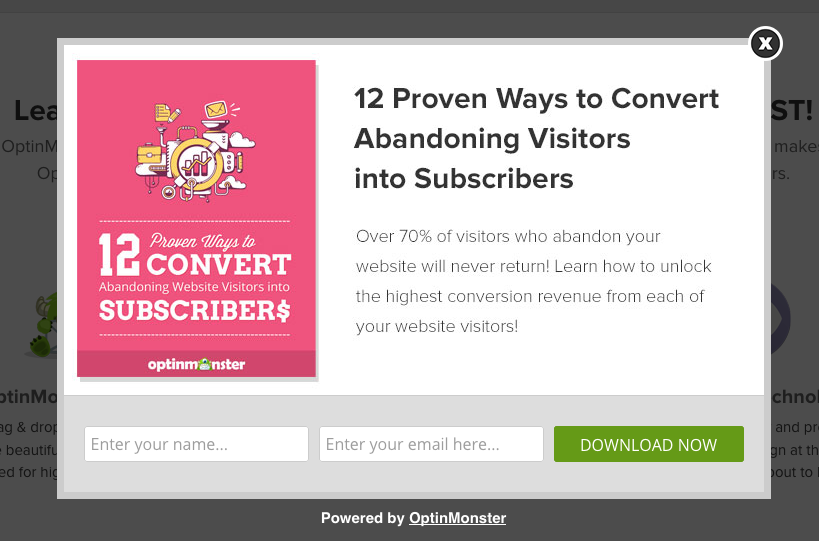
Here is an exit intent popup which actually speaks about exit intent.
The Free Email Course
Joshua Earl, my favourite email copywriter, nails it when it comes to offering an email course that’s incidentally about email courses. Note the subtleties of this offer. An offer to help you boost income, but it’s fun. The privacy guarantee also assures the reader they’ll not be spammed. It also prepares the user mentally that they will be receiving nine emails for the first nine days after they register.
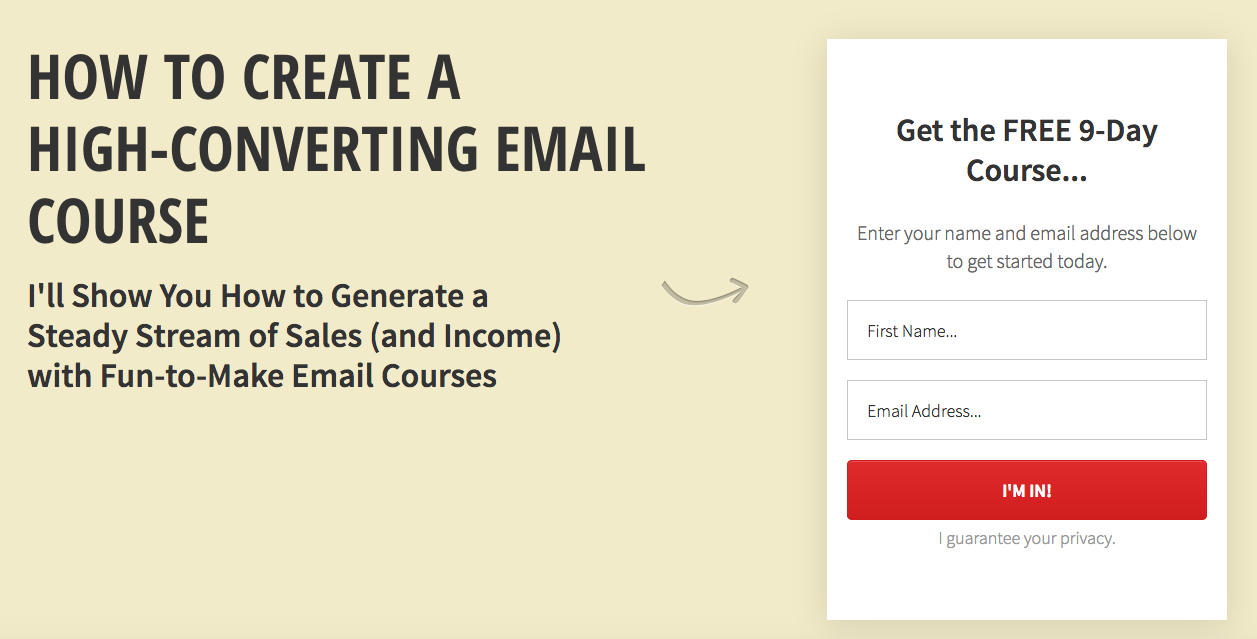
The Influencer
When you are already an influencer you can just rely on that to get people to subscribe to your email list. That’s a good place to be of course, and when that happens you can do this. And when you’ve got a beard like that, why wouldn’t somebody want to join your list?
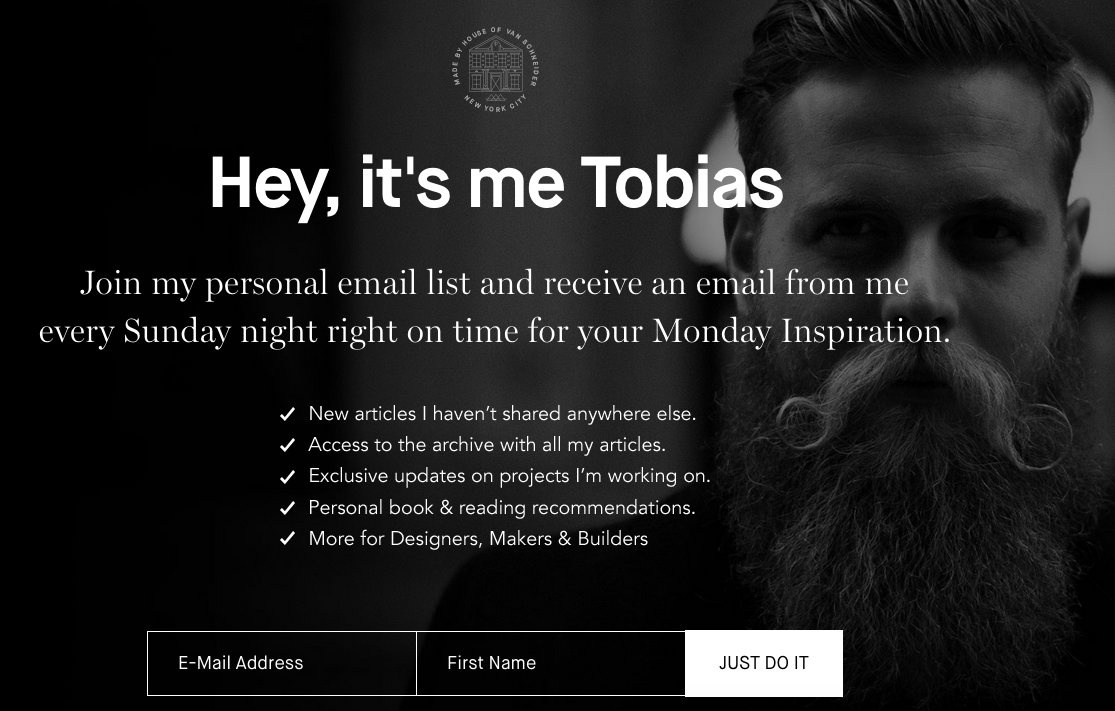
The Free Guide
Simple offer with simple solutions to a problem you are bound to have (specifically if you are a freelancer, which is the target demographic of this website).
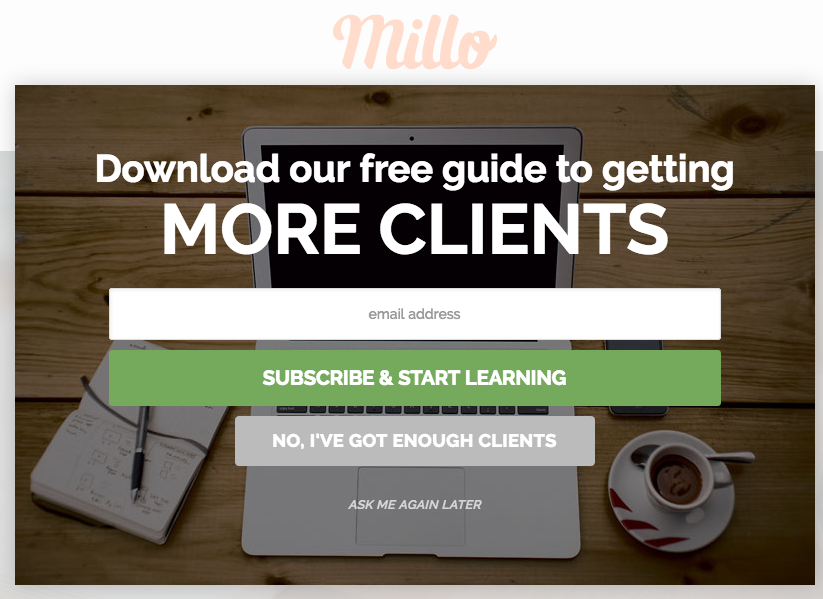
List Building Sins: What You Shouldn’t Be Doing
The Persistent Nag
No. Just no. Not just arrogant, but repeatedly arrogant. This is all take, no give.
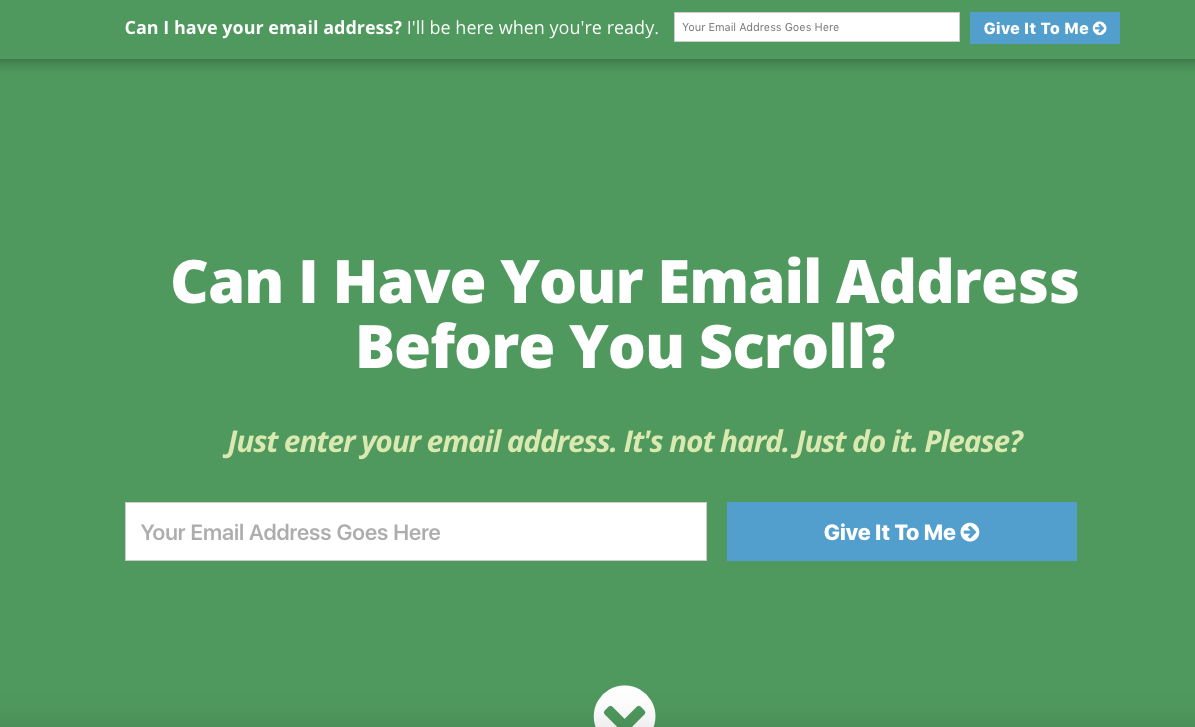
It gets worse.
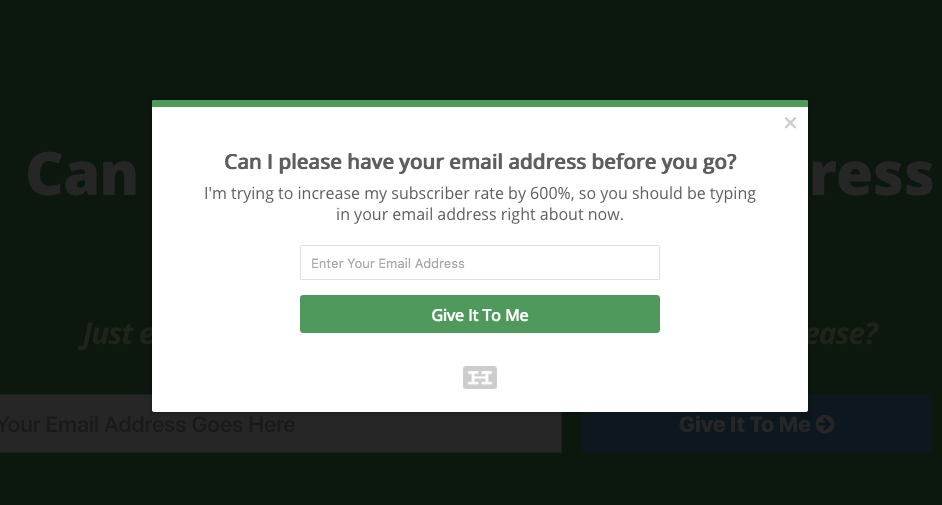
And then it really takes the biscuit.
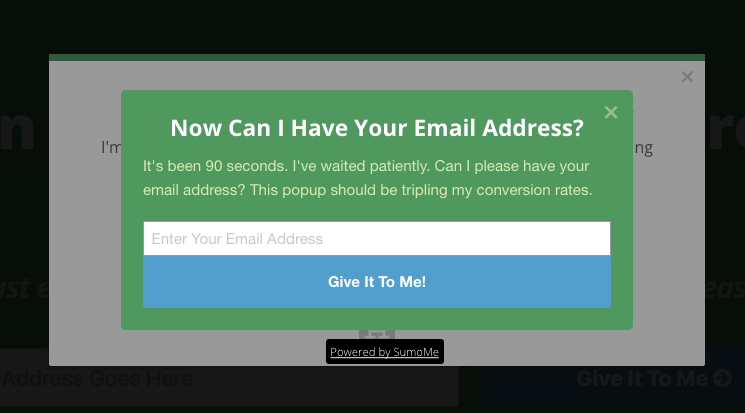
If you scroll down the page, you’ll see that we’ve also got an in-post subscribe box, and then we get a slide-in sidebar.
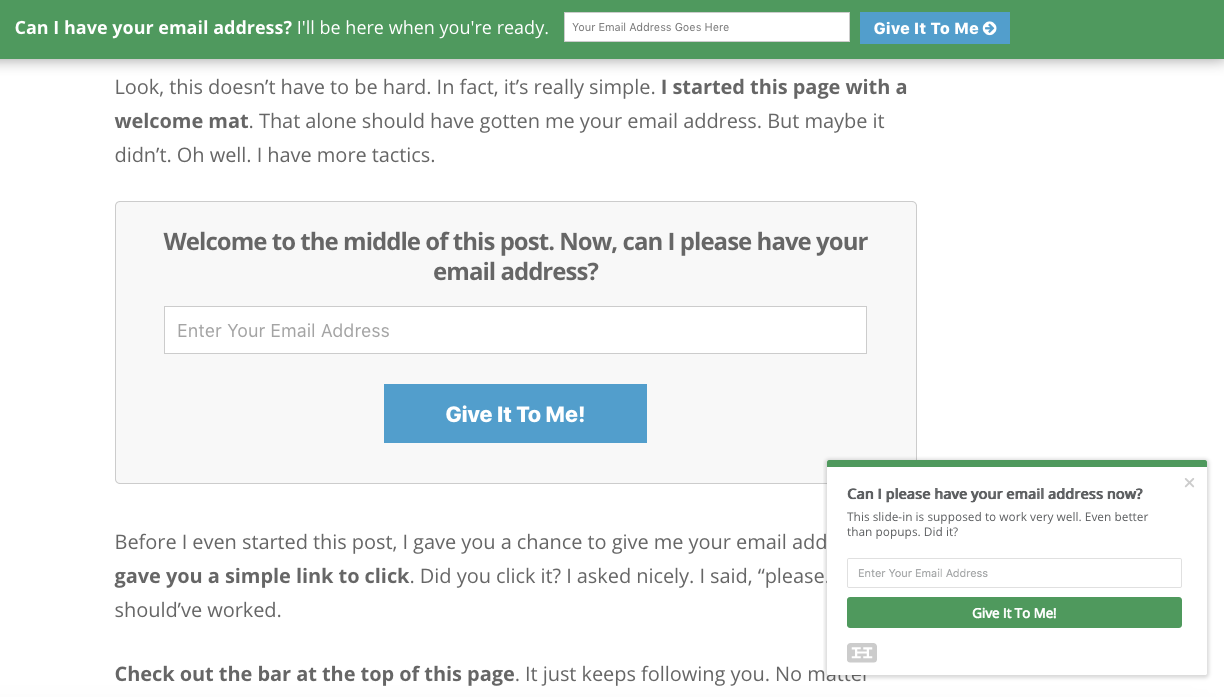
OK, this isn’t actually a real website.
All of the above are examples (courtesy of moneylab.com) of how you could combine all of what we have discussed above to create a terrible user experience.
The Poor Offer
Not a very compelling offer is it?
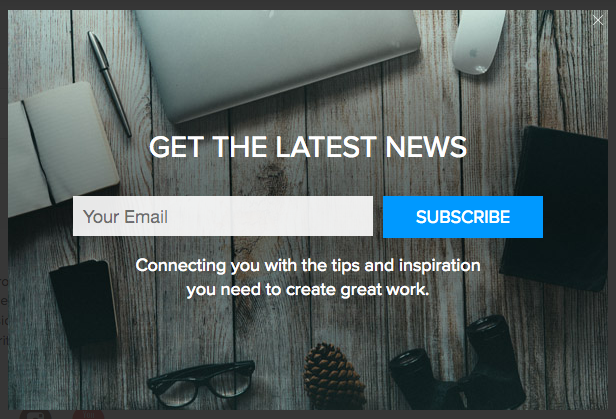
Or even poorer.
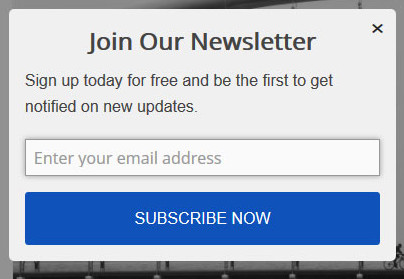
The Submit Button
From the dictionary definition of “Submit”
Submit: “Accept or yield to a superior force or to the authority or will of another person.” / “present (a proposal, application, or other document) to a person or body for consideration or judgment.”
None of the above meanings apply to your list building offer, right? Don’t use the “Submit” as your CTA phrase, just don’t.
The “Submit” phrase is a remnant of programming a form in HTML. But what are you submitting? If you have a CTA, use a keyword that is relevant to your offer – Download, Give Me, Click, Apply.
The Very Busy Offer
Your list building offer should be designed to be simple. Busy is overwhelming and will switch people off.
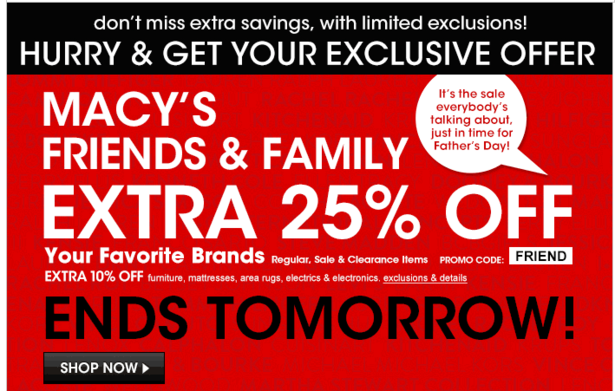
The Bad Design
The choice of colors and contrast is very important in email list building design. If you’re not a designer you might want to thinking about employing one to help you.
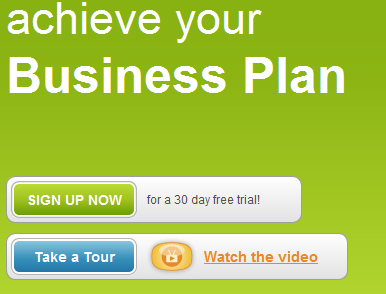
Aggressive Methods vs Passive Methods – What Works Best?
There are two types of methods to show your users your call to action. I like to call them the passive and the aggressive.
An aggressive CTA is one that actually stops the user from what they are doing (reading your article) and asks them to take action, e.g a page that takes over the screen completely and requires the user to subscribe or dismiss it.
A passive CTA is one that presents the opportunity to the user to take action, but the user can decide to ignore the opportunity, e.g. an in-content subscribe box.
Aggressive methods such as page takeovers and pop-ups have a much better conversion ratio, especially if you put the right offer in place. The downside of this is that some people find these aggressive actions quite annoying. You might have people abandoning your page just for that.
Statistically, aggressive methods work much better.
The key to make them work is to once again make sure you are providing value. That means that your user will go from:
“Oh heck, another popup, where is the close button?”
to
“Wow, I really need this right now! I’ll have to check it out right away.”
You’ve turned something aggressive into something that offers real and immediate value.
Regardless of the offer, some people will still be turned off by aggressive methods. You have to decide whether this is a risk worth taking or whether you should just stick to passive methods.
Passive methods are unlikely to annoy the user because they can simply be ignored. Yet the fact that users can glance over them will implicitly mean a lower conversion ratio.
5. The List Building Banner
One of the hottest places you can have to capture a user’s email address is the very first thing they see: the very top of your homepage. This is one of the most frequently viewed parts of your website so you will want to take advantage of that level of exposure to push your offer to as many people as possible.
Now if you really want to be aggressive, put that banner up on each page of your site. That way, as soon as somebody lands on your site, the first thing they see is the offer they can’t refuse.

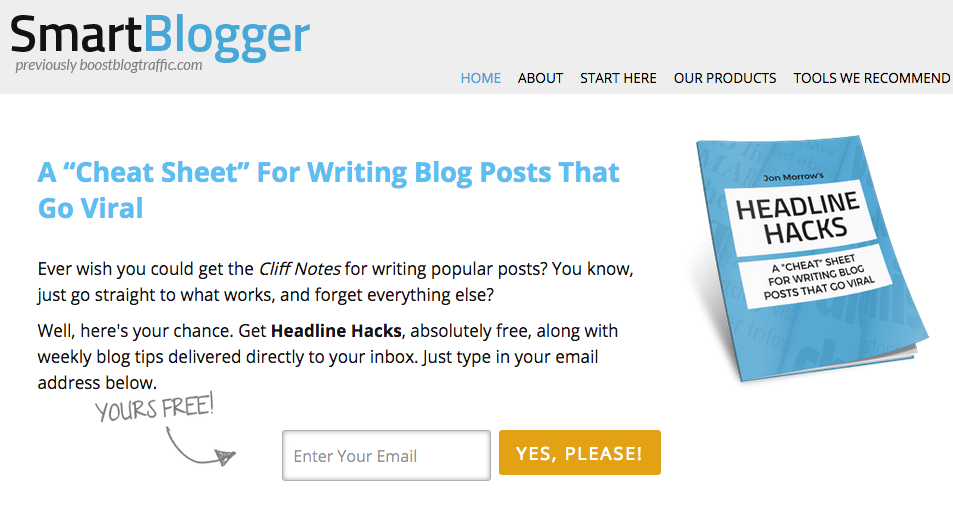
This, of course, will take a design rework of your site. This is something you should plan for from day one, ideally.
6. Timing Is Everything. And Location, Location, Location!
So far we’ve discussed the reasoning and the logic behind successful email list building. We’ll now look at the when and where of email list building.
I’ve already explained how earning a user’s trust is key to getting a user’s email address.
So how do you choose the right timing to make them an offer they can’t refuse?
You need to make the offer at the moments when users are most engaged and most satisfied with the content you’re giving them.
There are three best timings to get a fully engaged user:
- After the introduction to the article: Most times, whether your article will be read or not, is determined by the introduction of the article you have written. If your visitor gets past the introduction, chances are you have them hooked. If you are offering a free download, this is probably the best place to offer it, right after the intro.
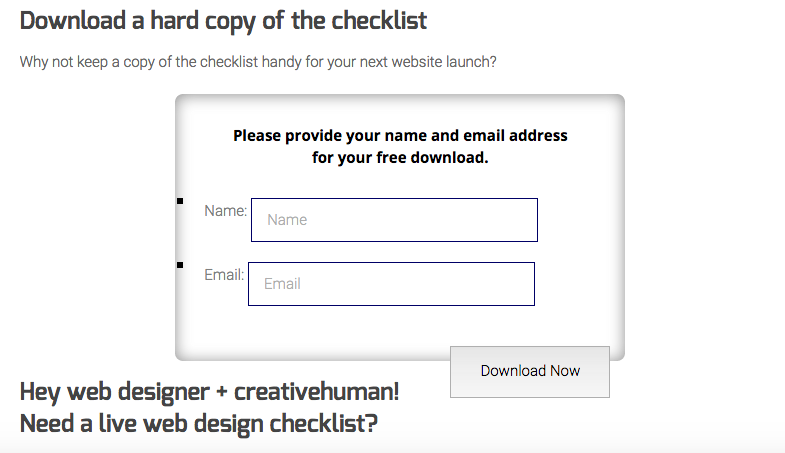
- In the middle of the article: A user in the middle of your article is fully immersed in the content. They have taken the time and effort to actually read past the first few paragraphs and you have managed to keep their interest. The middle of the article is a very good location to make them an offer they can’t refuse.
This is an example which you can see on our very own WPMU DEV blog. You’ve probably seen this over and over again here. That’s because the visitor is immersed in the content and is ripe for the offer. To see the example, scroll up a few and see our offer:
“1.6 million WordPress Superheroes read and trust our blog. Join them and get daily posts delivered to your inbox – free!”
- The closing paragraph of your article: If your user has gotten to the end of the article, congratulations! You’ve written an article that has kept the user on your website for the entire length of the article. If you read my recommended reading earlier in this post, The Psychology of the Call to Action, you’ll know that this is a very critical point and is one where the human brain is expecting to make a decision. Help the user make that decision to move to the next phase of “solving their problem” and make them an offer they can’t refuse.
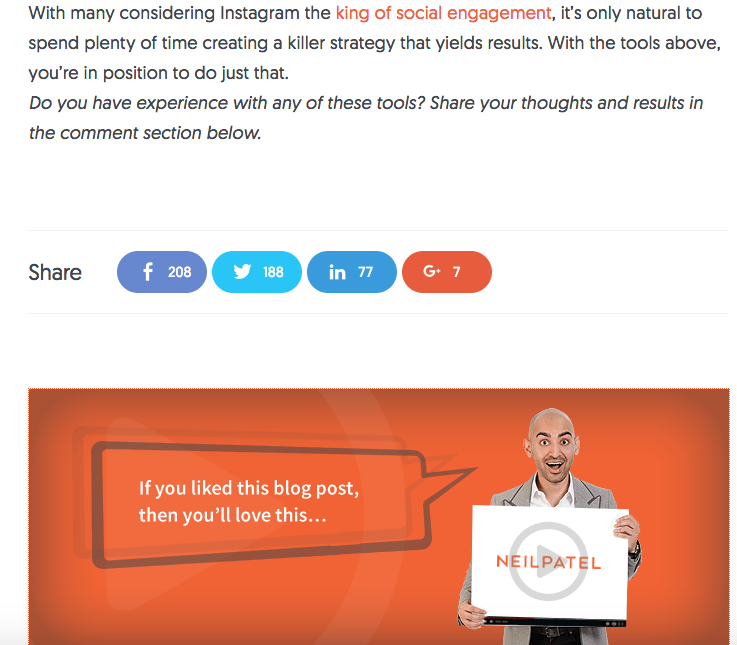
7. What Location Doesn’t Work? (Unless You Really Make a Spectacular Offer)
The sidebar.
Sidebars have been used and abused to display adverts, “Read More,” and lots of other non-essential content that most users simply zone out these locations – they become blind to any content located in sidebars.
If you “hide” your offer in the sidebar, chances are it’s not going to get much attention and you’re not going to get many conversions.
Earlier in this article, I mentioned Neil Patel, a master in conversions who can make a good CTA work anywhere, including the sidebar. You can see that this sidebar CTA offer is great for the demographic, it will work anywhere.
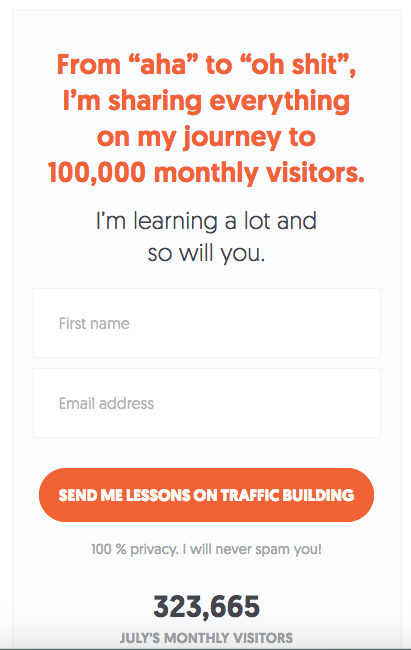
Now, onto the action. Let’s see how to set some of these up list-building techniques with WordPress.
8. How to Perform Email List-Building in WordPress
As always, at WPMU DEV we’ve got quite a few ways to help you get started with your list building efforts.
We have you covered both in terms of passive and somewhat aggressive methods too.
First of all, it’s a good idea to keep email subscribers in a list that can be automatically maintained and to whom you’ll be able to send emails to after you’ve built your list of email subscribers.
e-Newsletter is a full-fledged newsletter package for keeping in touch with your email subscribers.
1. The Download Against Email
When you’ve actually created an excellent article that has a complimentary downloadable asset, you really want to implement a download against email function.
There are multiple WordPress plugins that can enable you to do this. My favourite ones are Double-Opt-In For Download and Email Before Download.
The great thing about the former is that it automatically performs a double opt-in. For your user to get the download they have to confirm their email address. This is because the actual download link is sent to them by email. This allows you to eliminate a bunch of junk email addresses.
2. The Pop-Up
OK, so you’re probably not very impressed with this suggestion.
But wait, there is a massive difference between pop-ups that suck and pop-ups that convert.
Done right, the pop-up (or pop-in, or whatever you want to call it), is one of the most effective ways to get your visitor to take a specific action.
I’m going to explain the difference between a pop-up that converts and one that doesn’t.
Let’s consider Hustle, WPMU DEV’s new opt-in plugin. It’s the perfect tool to enable various forms of pop-ups with various CTAs.
The great thing about Hustle is its absolute flexibility. We want to create a CTA that is tailor made for the content the user is viewing right now, which is why we want to use a plugin that is fully configurable and flexible to our requirements.
I won’t go into all of the configuration details available in Hustle – it’s absolutely easy to configure – so you should go give it a spin yourself.
Here are my recommendations for creating a popup that converts:
Get the Timing of the Popup Right
The earlier you make users an offer they can’t refuse the better. Some people drop the offer only when the user is about to leave, but that may be too late. I’d suggest being aggressive here: 10 seconds after the user starts reading the article, which is about as aggressive as you can get. The more seconds you allow, the larger the possibility that you’ve lost the user’s interest. Twenty seconds is fine too – you’ll have given the user some time to settle in. Overall, if your primary aim is email list-building, the quicker the better.
There is another possibility you may use. This is quite a nice middle ground, though the conversion ratio will be lower than more aggressive popups.
You can choose to show the pop-up when a user has scrolled through a specific percentage of your content. Showing the pop-up after 20% of the article has been read is good timing but you run the risk of losing some of the first users.
The key to knowing what percentage you should set this at is to know how much of your content is actually being read. Ideally, you would use a content analysis tool to know how much of your content is being read. Then set the percentage to 5% less than the average content being read. That way, most of your readers will actually see the pop-up.
Show Different Pop-Ups and Offers for Different Categories
Remember a few paragraphs back I said that you should diversify your offer? It’s my very strong recommendation that you create tens of different kinds of pop-ups with different CTAs all targeted towards the specific content the reader is viewing. The more targeted the offers, the larger the conversion rate you’re likely to get.
You should at the very least have one different pop-up CTA for each category.
The Higher the Frequency of the Pop-Up, the Better the Conversion Ratio
This is also a question of aggressiveness. The most aggressive you can get is to show the pop-up always and on every page. The number of conversions you get will be higher, though the risk of annoying a user with pop-ups may also increase.
Spend Time and Money on Getting the Pop-Up Design Right
Get your user to trust you with a great pop-up design. You’ll want to spend as much time, money and design time as necessary to get this one right. Your design must be spot-on. Design that can be trusted. Also, remember that the right imagery can make a real difference. Let’s illustrate this with an example.
Which design would you trust? Which one looks like they care about you?
This one?
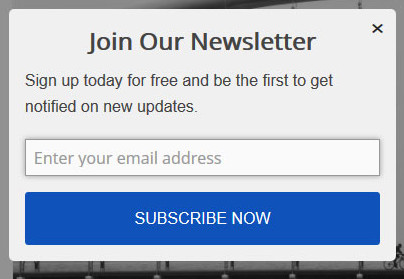
Or this one?
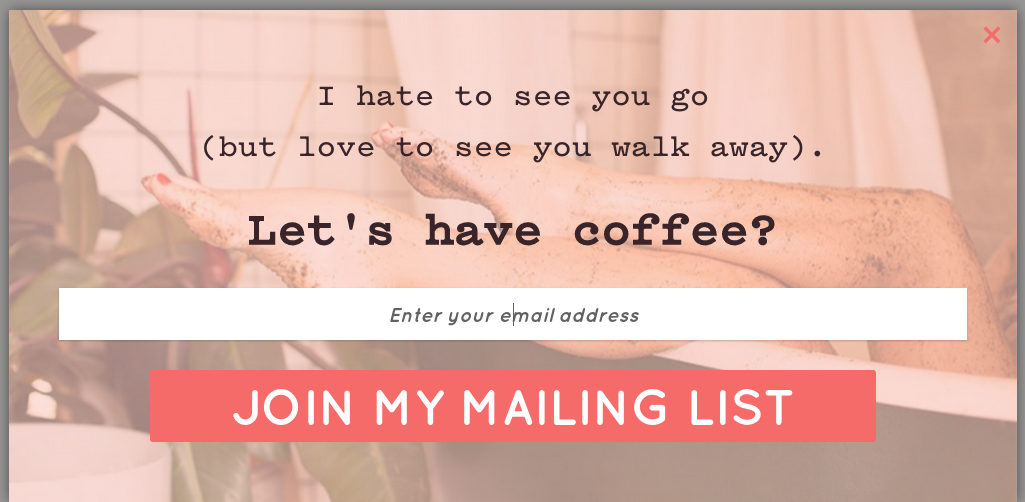
Want to make it aggressive? In the Hustle pop-up Custom CSS section, add the following code to make the pop-up takeover the entire user’s screen.
div.wpoi-popup-overlay {opacity: 1;}
From this:
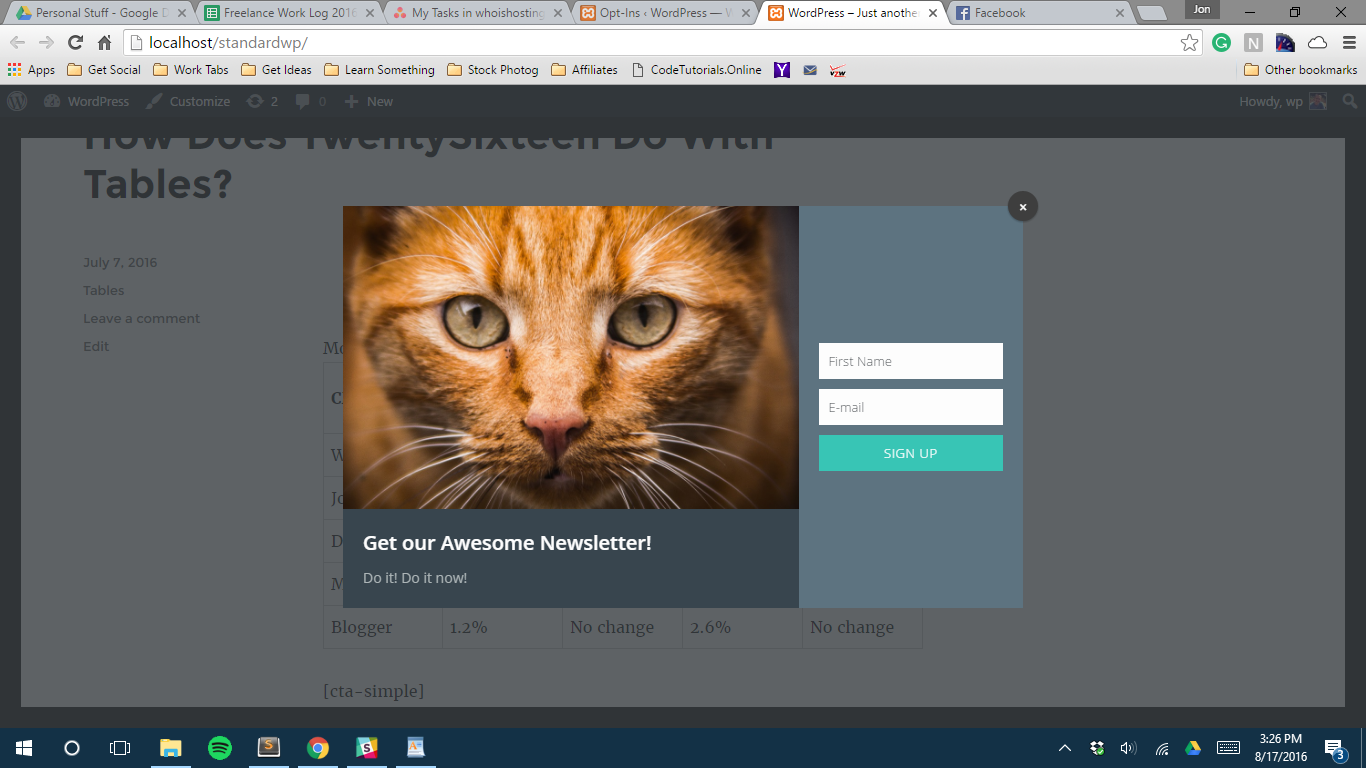
To this:
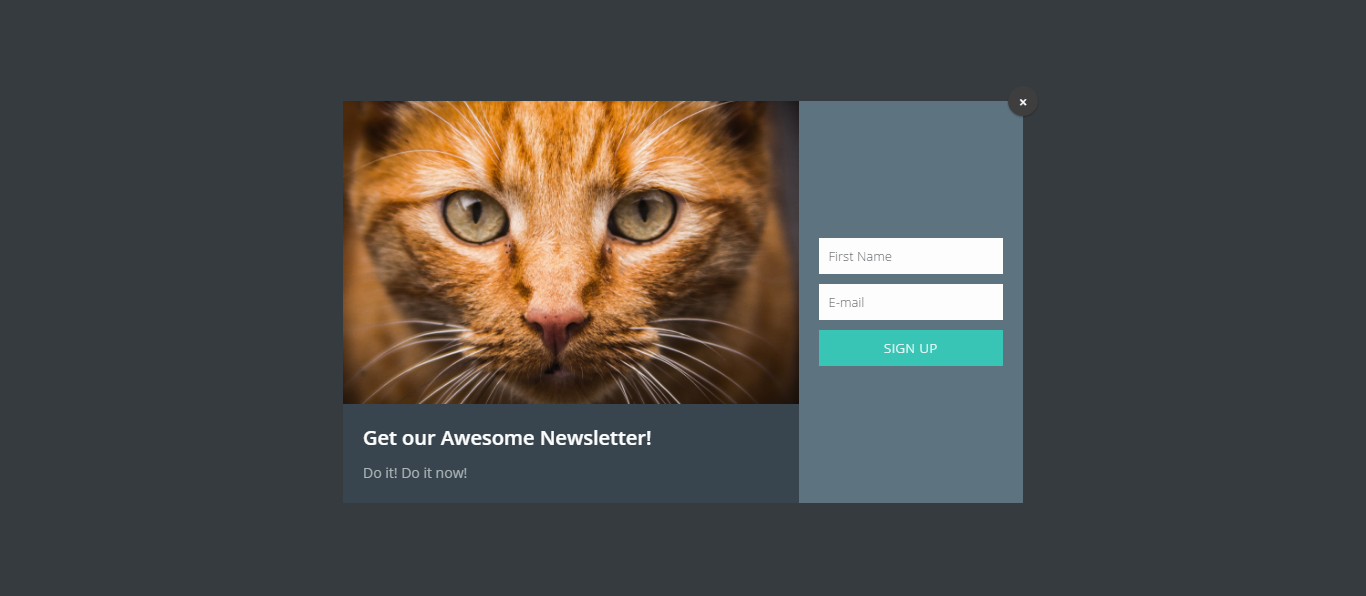
3. The In-Content Opt-In Widget Shortcode
A few paragraphs up we looked at how a user can become immersed with your content as they are reading it.
So that’s, of course, where you should make the offer they can’t refuse.
Once again, Hustle comes to the rescue, enabling us to drop a widget right in the middle of our content.
When you create a Hustle pop-up, a WordPress shortcode will be created with the following syntax:
[wd_hustle id="<name_of_optin>"]
Wherever you want your opt-in to appear in the text of your WordPress article, just enter the shortcode and this will be replaced with the opt-in you have designed.
4. The Slide-In
A slide-in widget is another semi-aggressive pop-up. It’s not as aggressive as a pop-up or a page takeover, but it’s not as passive as an in-content widget.
Hustle once again comes to the rescue to allow you to create slide-in widgets.
The parameters are not very different from those of the pop-up, with the only difference being that rather than seeing a pop-up you’ll get the pop-up sliding into the content.
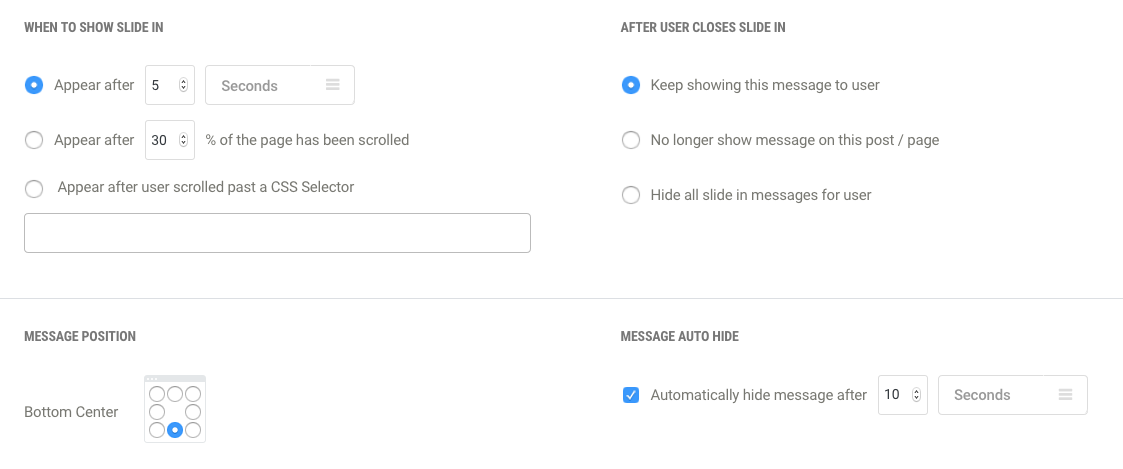
5. The Widget
Although we’ve said that widgets in the sidebar or other locations that aren’t prominent may not work very well, if you do have a great compelling offer you can still create a widget effectively.
Creating an email list building widget is easy to do with Hustle. Once you’ve designed your widget, activate the widget in the settings.

In Appearance > Widgets, add the Hustle widget to the theme widget position where you want it to appear.
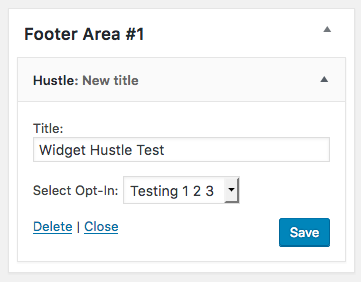
And then select the widget you have designed in Hustle.
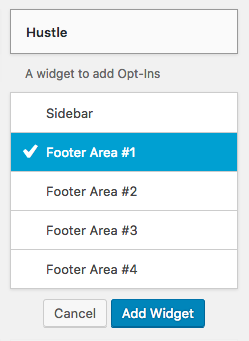
6. The List Building Banner
Using the shortcode or widget function, you should be able to easily implement a list building banner using Hustle.
Design an appropriate banner with the right offer and then using either a widget (which shows up in the appropriate position) or the shortcode, add the opt-in to your homepage.
9. Test, Test and When You’re Done Testing, Test Some More
I’ve given plenty of suggestions and recommendation of what we believe are effective ways of increasing your email list with WordPress through relevant offers you cannot refuse.
Yet, it’s ultimately you and your users who will decide what works best for your website.
You’ll have to create a number of variations of the email list building suggestions we’ve made and then see what works best for you and your users. When you determine which types of offers are working best for you, try tweaking each offer a bit to see whether it converts better (or worse).
Keep on testing slowly until you find the optimal conversion rate.
Just for you to have a bit of a measuring stick, here are rough numbers that are probably useful for comparison purposes: this article by SumoMe shows the conversion ratios across the internet for different types of list building formats.
Email sign-ups (all formats): 1.06%
If you’re converting better than this, well done! If not, something is seriously wrong with your offer – time to go back to the drawing board.
Sites with the highest conversion ratios convert at roughly 7%.
If you are converting at anything about 5% you’re doing great. Anything around the 3% mark means you’re doing OK but you’ve got room for improvement.
Anything lower than 2 to 3% means, you should rethink your offer and come up with something better or diversify your offer further.
10. Maintain the Trust of Your Email Subscribers
One you’ve actually convinced your visitor to trust you with their email address, how do you maintain the trust?
- Deliver the offer: You’ll need to first and foremost make sure you deliver on the offer. You’ll need to put some automation in place which actions the offer you made.
- Don’t become a salesman: I discussed above that you should be able to build a relationship with your user. Create an automated email campaign that builds on that relationship.
Even, if you want to eventually make a sale, you’ll need to first explain in a non-salesy way how your “product” is going to help solve your user’s problem.
Start your first few campaigns by sending a few emails that pique your user’s interest and offers tidbits towards solving the problem they needed solving. Eventually, you’ll be able to switch to a bit of a sales pitch.
Even after you’ve made your sales pitch, your user may still not be ready to buy. Keep helping the user regardless. If you keep showing your users that you are there to make their lives better, when the time is right for them you’ll be in their good books.
Successful WordPress List Building Done Right
There are quite a few things you’ll need to keep in mind if you want to be successful building a solid email list for your WordPress website.
Primarily, however, make sure to focus on the following:
- Write compelling content to make sure you pump up your visitor
- Give before asking. Make them an offer they can’t refuse (in exchange for their email address)
- Design an offer that is trustworthy
- Be a little bit aggressive without being too annoying
- Test until you find what works and what doesn’t work for your website.
Image credits: 7 Phases.
Share article
Create your free account to post your comment
Login to post your comment